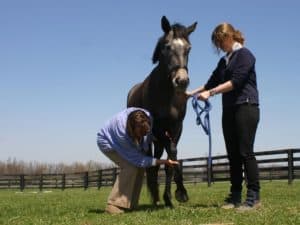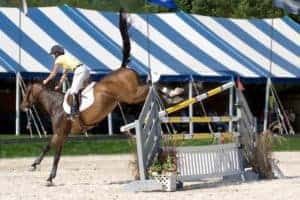Equine Joint Infection Risks in the Clinic vs. the Field

To guide veterinarians’ use of these potent medications, Lynn Pezzanite, DVM, MS, PhD, Dipl. ACVS-LA, assistant professor of equine emergency and critical care at Colorado State University’s (CSU) Veterinary Teaching Hospital, in Fort Collins, assessed the risk of joint infection in horses injected in hospital versus field settings. She presented her findings at the 2021 American Association of Equine Practitioners (AAEP) Convention, held Dec. 4-8 in Nashville, Tennessee.
“Veterinarians often include antibiotics with joint injections even though there’s no evidence it reduces infection risk overall,” Pezzanite said. “One justification cited for their use is preventing infection in the field, where conditions may be considered ‘dirtier.’ This is concerning because of growing antibiotic resistance.”
Based on previous reports, she said 42-60% of equine practitioners include antibiotics with joint injections. Research has shown fewer than 0.1% of injections—regardless of antibiotic use—however, result in infection. Because environmental contamination might put horses at risk of infection, Pezzanite performed a study to quantify synovial sepsis frequency by environment.
She and her team retrospectively reviewed CSU medical records from horses receiving joint injections from 2014 to 2018. For each injection, they noted the medications used, location performed (field vs. hospital), whether the horse developed sepsis and, if so, when.
They found that of 3,866 intrasynovial injections performed in 1,112 horses during 1,623 sessions, only four of the joints developed synovial sepsis—a low rate of just 0.1%, which is consistent with other study findings. Three occurred in the field and one in the clinic. All recovered after lavage (flushing the affected joint) and antibiotic therapy. The treating veterinarians had administered antibiotics preventively in 42.1% of the horses, including two that developed sepsis. Factors such as time of year and number of structures injected did not impact infection rate.
“Whether practitioners performed the injection in the field or without antibiotics did not affect the rate of infection,” said Pezzanite.
In her take-home for veterinarians she said, “Aspects within our control as veterinarians (e.g., aseptic technique, clipping the hair around the injection site) are likely more important to reduce the risk of infection” than the environment where the procedure is performed or the inclusion of antibiotics.

Written by:
Alexandra Beckstett
Related Articles
Stay on top of the most recent Horse Health news with











